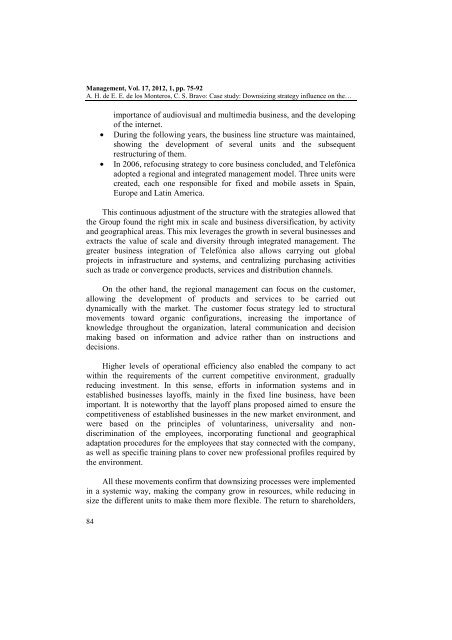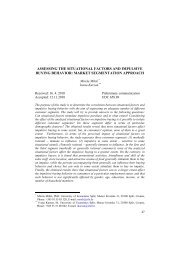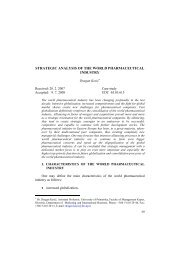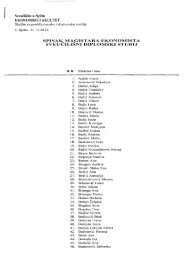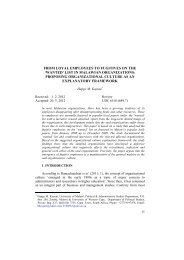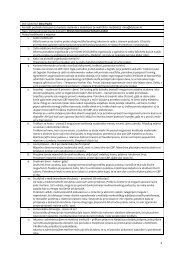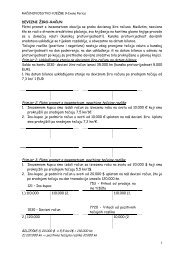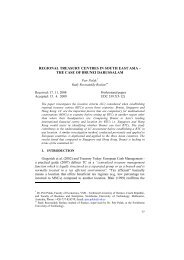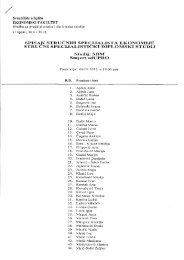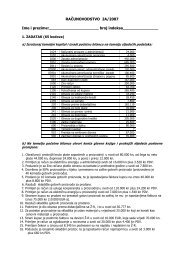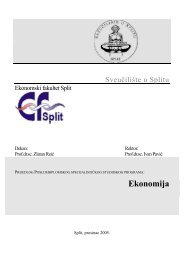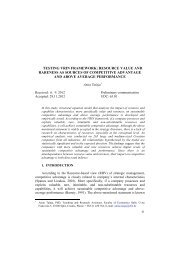Case study: Downsizing strategy influence on the structure of the firm
Case study: Downsizing strategy influence on the structure of the firm
Case study: Downsizing strategy influence on the structure of the firm
You also want an ePaper? Increase the reach of your titles
YUMPU automatically turns print PDFs into web optimized ePapers that Google loves.
Management, Vol. 17, 2012, 1, pp. 75-92<br />
A. H. de E. E. de los M<strong>on</strong>teros, C. S. Bravo: <str<strong>on</strong>g>Case</str<strong>on</strong>g> <str<strong>on</strong>g>study</str<strong>on</strong>g>: <str<strong>on</strong>g>Downsizing</str<strong>on</strong>g> <str<strong>on</strong>g>strategy</str<strong>on</strong>g> <str<strong>on</strong>g>influence</str<strong>on</strong>g> <strong>on</strong> <strong>the</strong>…<br />
84<br />
importance <strong>of</strong> audiovisual and multimedia business, and <strong>the</strong> developing<br />
<strong>of</strong> <strong>the</strong> internet.<br />
• During <strong>the</strong> following years, <strong>the</strong> business line <strong>structure</strong> was maintained,<br />
showing <strong>the</strong> development <strong>of</strong> several units and <strong>the</strong> subsequent<br />
restructuring <strong>of</strong> <strong>the</strong>m.<br />
• In 2006, refocusing <str<strong>on</strong>g>strategy</str<strong>on</strong>g> to core business c<strong>on</strong>cluded, and Telefónica<br />
adopted a regi<strong>on</strong>al and integrated management model. Three units were<br />
created, each <strong>on</strong>e resp<strong>on</strong>sible for fixed and mobile assets in Spain,<br />
Europe and Latin America.<br />
This c<strong>on</strong>tinuous adjustment <strong>of</strong> <strong>the</strong> <strong>structure</strong> with <strong>the</strong> strategies allowed that<br />
<strong>the</strong> Group found <strong>the</strong> right mix in scale and business diversificati<strong>on</strong>, by activity<br />
and geographical areas. This mix leverages <strong>the</strong> growth in several businesses and<br />
extracts <strong>the</strong> value <strong>of</strong> scale and diversity through integrated management. The<br />
greater business integrati<strong>on</strong> <strong>of</strong> Telefónica also allows carrying out global<br />
projects in infra<strong>structure</strong> and systems, and centralizing purchasing activities<br />
such as trade or c<strong>on</strong>vergence products, services and distributi<strong>on</strong> channels.<br />
On <strong>the</strong> o<strong>the</strong>r hand, <strong>the</strong> regi<strong>on</strong>al management can focus <strong>on</strong> <strong>the</strong> customer,<br />
allowing <strong>the</strong> development <strong>of</strong> products and services to be carried out<br />
dynamically with <strong>the</strong> market. The customer focus <str<strong>on</strong>g>strategy</str<strong>on</strong>g> led to structural<br />
movements toward organic c<strong>on</strong>figurati<strong>on</strong>s, increasing <strong>the</strong> importance <strong>of</strong><br />
knowledge throughout <strong>the</strong> organizati<strong>on</strong>, lateral communicati<strong>on</strong> and decisi<strong>on</strong><br />
making based <strong>on</strong> informati<strong>on</strong> and advice ra<strong>the</strong>r than <strong>on</strong> instructi<strong>on</strong>s and<br />
decisi<strong>on</strong>s.<br />
Higher levels <strong>of</strong> operati<strong>on</strong>al efficiency also enabled <strong>the</strong> company to act<br />
within <strong>the</strong> requirements <strong>of</strong> <strong>the</strong> current competitive envir<strong>on</strong>ment, gradually<br />
reducing investment. In this sense, efforts in informati<strong>on</strong> systems and in<br />
established businesses lay<strong>of</strong>fs, mainly in <strong>the</strong> fixed line business, have been<br />
important. It is noteworthy that <strong>the</strong> lay<strong>of</strong>f plans proposed aimed to ensure <strong>the</strong><br />
competitiveness <strong>of</strong> established businesses in <strong>the</strong> new market envir<strong>on</strong>ment, and<br />
were based <strong>on</strong> <strong>the</strong> principles <strong>of</strong> voluntariness, universality and n<strong>on</strong>discriminati<strong>on</strong><br />
<strong>of</strong> <strong>the</strong> employees, incorporating functi<strong>on</strong>al and geographical<br />
adaptati<strong>on</strong> procedures for <strong>the</strong> employees that stay c<strong>on</strong>nected with <strong>the</strong> company,<br />
as well as specific training plans to cover new pr<strong>of</strong>essi<strong>on</strong>al pr<strong>of</strong>iles required by<br />
<strong>the</strong> envir<strong>on</strong>ment.<br />
All <strong>the</strong>se movements c<strong>on</strong><strong>firm</strong> that downsizing processes were implemented<br />
in a systemic way, making <strong>the</strong> company grow in resources, while reducing in<br />
size <strong>the</strong> different units to make <strong>the</strong>m more flexible. The return to shareholders,


